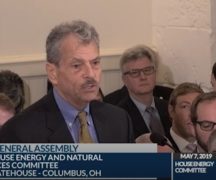Should nonprofit organizations that spend money on Ohio elections be forced to publicly disclose who funds them?
Some lawmakers say yes and are trying once again to change the state’s campaign finance law in an effort to make political spending more transparent.
State Reps. Allison Russo, D-Upper Arlington, and Bride Rose Sweeney, D-Cleveland, have reintroduced a bill nicknamed the “Ohio Anti-Corruption Act.” Two-dozen Democrats in the Ohio House of Representatives have co-sponsored the bill.
State law requires political candidates to publicly report donations to their campaigns. Organizations such as political action committees (PACs) are also required to report who funds them and what causes the PAC spends money on.
The House Bill 6 scandal, which led to the July 2020 arrests of House Speaker Larry Householder and several other Republican operatives, helped draw attention to a noteworthy exception in Ohio’s campaign finance laws.

Nonprofit 501(c)(4) organizations, known as “social welfare groups,” are not required to report their donors.
This was a key component to the House Bill 6 scheme, prosecutors have alleged, with corporate money being funneled through a 501(c)(4) group secretly controlled by Householder. This money then supported the 2019 passage of a $1.3 billion nuclear bailout bill and was also used to defeat a ballot initiative to overturn the bill.
In the 10 months since the scandal broke, lawmakers of both parties have pushed for campaign finance reform in order to prevent “dark money groups” from adversely influencing Ohio’s political process.
Central to these varying proposals is a component to require the nonprofits to disclose their donors just like other political entities.
Russo and Sweeney first proposed the Anti-Corruption Act days after Householder’s arrest. It did not receive a hearing before the term concluded at the end of 2020.
They are now trying again. House Bill 306 also has a provision dealing with foreign spending on elections. Foreign corporations are already prohibited from making campaign donations, but HB 306 would go further in prohibiting spending from American-based corporations that have some foreign ownership.
Householder, a Glenford Republican, awaits trial on corruption charges. As the Ohio Capital Journal has reported, two Householder associates have already pleaded guilty — as did Generation Now, the dark money group at the center of the HB 6 scheme.
Householder has maintained his innocence. He remains in office representing the House’s 72nd District, though he holds no committee assignments this term and has yet to introduce any piece of legislation thus far in 2021. He has rejected widespread calls to resign from fellow Republican lawmakers and officials from his rural district representing Perry, Licking and Coshocton counties.
The House Majority Caucus has declined to take a vote to expel the former speaker from the chamber.
House Republicans introduced their own bill earlier this term dealing with dark money spending. House Bill 13, sponsored by Reps. Diane Grendell of Chesterland and Mark Fraizer of Newark, would only require nonprofits publicly disclose donations given to them for the purpose of influencing elections. Donations given for apolitical, social welfare purposes could be kept private.
HB 13 has received two hearings so far and has received initial support from the good government group Common Cause Ohio as well as a political action committee known as Wolf-PAC that fights for improvements to campaign finance law.
***
Also from Ohio Capital Journal:
CDC: Ohio’s opioid epidemic cost $72 billion in 2017
Ohio’s opioid epidemic caused an economic loss of more than $72 billion in 2017, the second most per capita of any other state in the U.S., according to CDC research.
The figure, published in the agency’s Morbidity and Mortality Weekly Report, is a sum of direct costs (health care, substance use disorder treatment, criminal justice etc.) and economic costs (lost productivity, reduced quality of life).
Some of the states most ravaged by the opioid epidemic — West Virginia, Ohio, New Hampshire, Kentucky, Massachusetts — all lead the nation in per capita economic costs to fatal opioid overdoses and opioid use disorder, the CDC found. The rankings in the study are limited to 38 states that met certain drug specificity requirements for mortality data.
Nationally, the CDC estimated the epidemic cost more than $1 trillion in 2017. READ MORE
Reports: Drug manufacturers and middlemen both responsible for rising consumer costs
The world of prescription drug pricing can be bewildering — intentionally so, some critics of the industry claim.
Whether that’s true or not, several reports this year show that the supply chain’s alchemy of list prices, rebates and net prices hurts consumers. And a U.S. Senate report says drugmakers and middlemen share the blame.
The media often breathlessly report increases in list prices of more-expensive, brand-name drugs. “Big drugmakers just raised their prices on 500 prescription drugs,” read the headline of a January story by CBS News, for example.
But the story didn’t mention that government payers, insurance companies and the middlemen they hire usually pay far less than the list price. As Johnson & Johnson owner Janssen Pharmaceuticals reported, the net cost of its branded drugs actually fell by 14.4% since 2016. READ MORE





